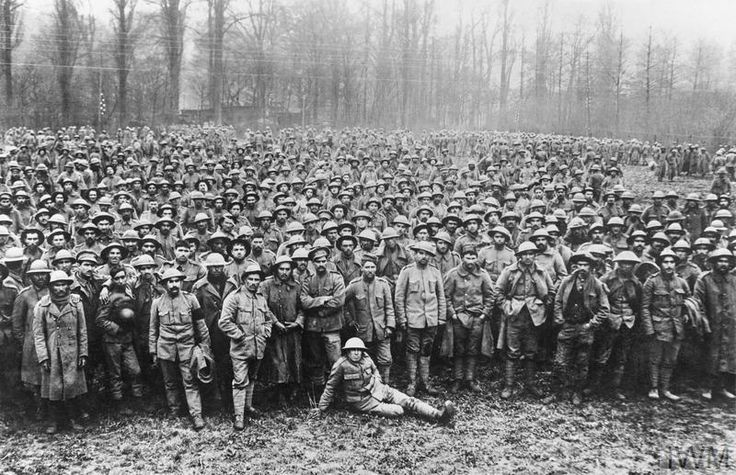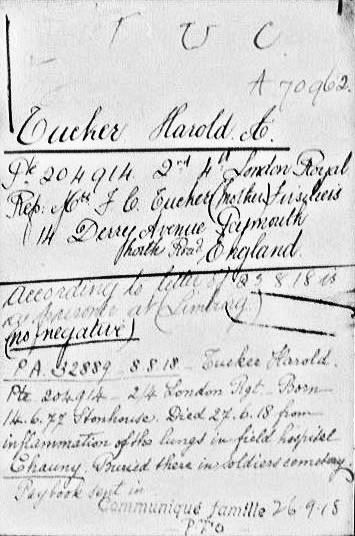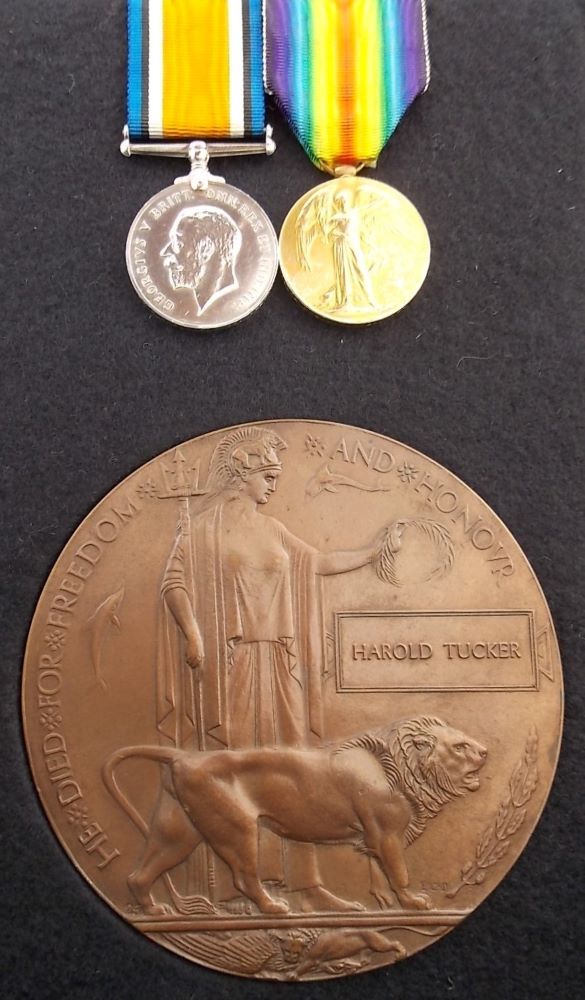
As Harold Augustus Tucker he was born on 14 June, 1877, at 9 Edgcumbe Street, in East Stonehouse, Plymouth, Devonshire, the third son of Frederick Charles Tucker, a shipwright, later Inspector of Ships at His Majesty's Dockyard, and then a hairdresser, and Emily Tucker (formerly Lamshead), employed as a newsagent and dockyard stationer. He had ten siblings: Florence Emily (1873); Frederick William James (1874); Ernest Charles (1876); Ethel Rebecca (1878/79); Percy Edgar (1881); William Rowling (1886); Arthur Edwin (1887); Mabel Doris (1888/89); Cyril (1890); and Violet Blanche (1894). All were born at East Stonehouse, where the family home, from 1877 to 1901, was at 9 Edgcumbe Street.
By 1911 the family home was at 34 Hillside Terrace, Mutley, Plymouth.
[William Rowling Tucker served as a Private, with the 2nd, 11th and 5th Battalions, the Devonshire Regiment, and latterly as a Private, in the Labour Corps. Arthur Edwin Tucker served as a Corporal, with the 5th Battalion, Devonshire Regiment.]
Harold Augustus Tucker entered the drapery trade, being shown as a tailor's apprentice, living at home in 1891.
By 1901 he was a draper's assistant, living with a multitude of other such employees at 9 St. Paul's Church Yard, in St. George by St. Paul, in the City of London.
However, by 1903, when he married, he had returned to Plymouth and was described as a draper's warehouseman.
On 20 August, 1903, at the Wesleyan Methodist Church in Edgcombe Street, he married Alice Roskilly, the daughter of John Roskilly, a carrier, of 45 Cremyll Street, in East Stonehouse. They were to have two daughters, Violet Doris (1905), and Muriel Emily (1908), both in London, where, between 1905-1911, they lived at 99 Hambalt Road, in Clapham, and, by the 1911 census, at 19 Sarsfeld Road, in Balham, where the family continued to live.

Harold Augustus Tucker's attestation papers have not survived for his service during World War One, and a summary of his service has had to be compiled from other documents. The gratuity paid to his widow, following his death, would indicate he enlisted in around May, 1917: however, another man, with the service number 204840, joined on 13 June, 1917, and that with the number 205105 joined on 7 July, 1917.
Harold Augustus Tucker, using just his first forename, enlisted (or was conscripted) at 27 St. John's Hill, in Battersea (Clapham Junction), which was the recruiting office for the 1/23rd (County of London) Battalion, the London Regiment (Territorial Force). He served as a Private, initially with the number, 28101, but was later allocated the number 204914, reflecting the number system adopted by the Territorial Force in 1917.
On 19 October, 1917, he entered France, to serve with the 2/1st Battalion, the London Regiment (Royal Fusiliers). On 6 February, 1918, this battalion disbanded in France, with its personnel having been drafted to the 2/2nd, 2/3rd, 2/4th and 1/4th Battalions, the London Regiment, with 12 officers and 280 other ranks being received by the 2/4th Battalion, on 30 January, which included Harold Tucker.
This unit had landed at Le Havre on 24 January, 1917, and formed part of the 173rd Brigade, 58th (2/1st London) Division. At the beginning of February, 1918, it was at Thezy-Glimont, re-organising, and from 7 February began moving towards St. Quentin: on 28 February it was ordered to Viry-Noreuil and Tergnier. On 2 March the battalion relieved the 2/3rd Battalion, the London Regiment, in the battle zone at Fargnier, and between 3-19 March the battalion's companies worked on defence positions, under the Royal Engineers. On 20 March the battalion rested, and was warned to 'prepare for attack', and be ready to man the battle positions at a moment's notice.
The next day, 21 March, saw the commencement of Kaiserschlacht, the German Spring Offensive. At 4.30 am the enemy barrage opened against the forward positions, and one hour later the companies were ordered to man the battle positions. At 6.00 am the enemy attacked the forward zone positions, and captured positions held by the 2/2nd Battalion, the London Regiment, who were in front of the 2/4th Battalion. By 11.00 am the enemy had gained a footing at the east end of Fargnier, but were completely held on the battle zone, in spite of repeated attacks, on all the 2/4th Battalion's posts. During the afternoon the 2/4th Battalion was reinforced by two companies of the 2/3rd Battalion, and at 3.00 pm, patrols were sent out in front of each company, who reported that the ground was covered with dead Germans. By 8.30 pm, although the enemy was still held, the battalion was ordered to withdraw, in order to conform with movements of the brigade on the left, and withdrew to the left side of the Crozat Canal. The retirement was carried out satisfactorily without the enemy's knowledge, or casualties, and new dispositions were completed by midnight. The battalion casualties that day were listed as 2 officers missing (believed prisoners of war) and 4 wounded, and an estimated 190 other ranks casualties: two platoons of 'C' Company were missing.
According to the medal roll, Harold Tucker's active service ceased on 21 March, 1918, leading to the assumption that he was one of the casualties on that day.
At 6.00 am on 22 March, the battalion was relieved on the west side of the canal bank, by the 2/8th Battalion, the London Regiment, and moved to the reserve line, behind Vouel, the relief being complete by 10.00 am, were the battalion re-organised into three companies, each with a strength of about 90. 'D' Company was on the left flank on the Vouel- Noreuil road; 'B' Company in the centre; and 'A' Company on the right: the battalion headquarters was at the Butte de Vouel, Tergnier, together with the headquarters of the 2/8th Battalion, London Regiment. At about 1.30 pm the enemy attacked positions on the canal bank and hard fighting ensued in Tergnier: at 6.30 pm the 3rd, 2/4th and 2/8th Battalions, the London Regiment, moved to Noreuil, and at night patrols were sent out and many prisoners, including a machine-gun and crew, were brought in. Casualties for the day were listed as 1 officer gassed, and 10 other ranks wounded.
The battalion was in the same positions at daybreak on 23 March, which began with a heavy ground mist making visibility very bad. At 8.00 am the French launched a counter-attack and succeeded in clearing the enemy at Tergnier, in front of the Butte de Vouel, but eventually fell back leaving that flank exposed. At about 11.00 am the ground mist cleared and enemy machine-guns enfiladed the battalion's positions from the north and south, while massed troops were pressing forward from the ruins of Vouel. At noon it was necessary for the troops to fight their way back to the position known as the Green Line, held by troops of the 6th Cavalry Brigade, in front of Noreuil: this position was held until about 6.00 pm when orders were received to withdraw to a new position at Chauny as the enemy had outflanked the forces in front of Noreuil, and was attacking the village from the north. At about 3.00 pm Major Grover had collected all available details at the transport lines, including 2 officers and 54 other ranks from the 2/4th Battalion, and formed a defensive line on the northern outskirts of Chauny. Later, Captain Askham, with about 120 men, fell back and reinforced this position. Casualties on this day were listed as: 6 officers wounded, and 1 missing, believed killed, and an estimated 150 other ranks, killed, wounded and missing, which would appear to have included Private Harold Tucker.
The war diary of the 173rd Brigade listed 270 casualties suffered by the 2/4th Battalion on 21-22 March, 1918. Officers Other ranks Total Killed: 32 32 Died of wounds: 3 3 Wounded: 9 9 Gassed: 1 3 4 Missing: 6 216 222 Totals: 16 254 270

The prisoner of war records, held by the International Red Cross, indicate that Harold Augustus Tucker was taken prisoner on 23 March, 1918, at Tergnier, and that he was a member of 'B' Company, 2/4th Battalion, the London Regiment, and therefore, under the command of Captain Askham.
After capture it seems evident that Harold Tucker remained in the same area, and was not transported to a prisoner of war camp in Germany: he was probably employed in work parties of prisoners, used to clear the battlefield area.
Harold Tucker died on 27 June, 1918, in a German Field Hospital at Chauny, from influenza and pneumonia: he was aged 41.

Initially, he was interred in Chauny German National Cemetery, which contained 15 British burials from between March-July, 1918. However, in May, 1919, these burials were exhumed and concentrated in Chauny Communal Cemetery British Extension, Aisne.
It appears that his death was not notified in England until 18 December, 1918. He had served for about 13 months, of which 166 days had been spent on active duty in France, 103 days with the 2/1st Battalion and 63 days with the 2/4th Battalion: he had spent 86 days as a prisoner of war.
Harold Tucker is also commemorated in a roll of honour deposited in a casket beneath the Plymouth War Memorial, listed as 'H. Tucker'.

Harold Tucker's service earned him the British War Medal, 1914-20; and Victory Medal, 1914-19. A memorial plaque and memorial scroll were also prepared and issued to commemorate his sacrifice.


